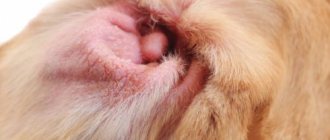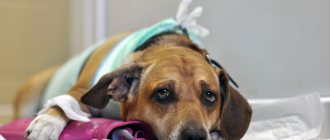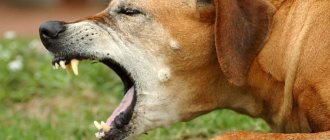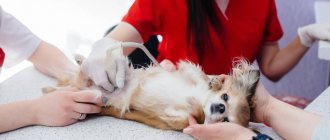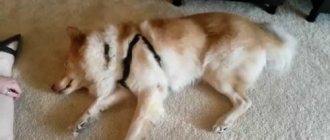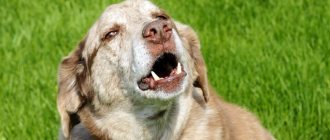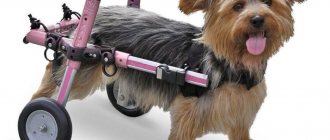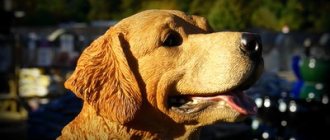Excess weight significantly shortens a dog's life, contributes to the development of a number of diseases and does not add attractiveness. The most common causes of obesity are overfeeding and physical inactivity. The fault for this always lies with the owner. Very rarely the problem is caused by serious illnesses, but even in this case the previous factors are at play.
It's not the dog's fault for gaining excess weight, it's the owner's.
Obesity in dogs leads to the development of:
- Cardiovascular diseases. As body weight increases, the heart works harder and over time begins to fail progressively.
- Diabetes mellitus. The sensitivity of receptors to insulin decreases. Cells stop “seeing” and using the hormone, causing blood sugar levels to rise and diabetes to develop.
- Diseases of the musculoskeletal system. Under excess weight, joints wear out and become deformed faster, causing chronic arthritis, arthrosis, etc.
- Decreased immunity. As a result, susceptibility to infectious diseases increases.
- Decreased reproductive function.
- Load on the liver. Up to the development of fatty degeneration.
- And of course, a decrease in the overall quality of life. Obese dogs find any movement difficult and short of breath, not to mention running after a ball. They become lethargic, spend most of their time sleeping, and have a very difficult time withstanding the heat.
Why does a dog become overweight?
Ways to combat obesity depend on its cause. The most common provoking factors include:
- Overfeeding.
The most common problem that arises due to periodic handouts from the table, improper feeding regimen and an abundance of fatty, high-calorie foods in the diet.
- Breed and genetic predisposition.
The risk group includes dachshunds, Rottweilers, bulldogs, Labradors, and pugs. If you adopted a puppy from obese parents, then you will have to monitor its weight with special care.
- Helminthiasis.
The toxins released by worms primarily promote weight loss, but can also slow down your metabolism.
- Lack of activity.
Each body requires a certain amount of calories to maintain the functioning of its internal organs. Exceeding the norm promotes weight gain, and underestimation promotes weight loss.
- Stress.
Animals react to nervous shock in different ways. Some eat it intensely, while others cannot take even a crumb into their mouth.
- Hormonal disorders.
This includes illness and castration, as well as periodic hormone surges during pregnancy and estrus. They slow down metabolism and promote weight gain.
- Taking certain medications.
They either act directly on metabolism or simply increase appetite.
It is quite easy to understand that the dog has recovered. To do this, you need to evaluate it visually and weigh it on a scale.
Features of the transition to dietary nutrition
Transferring an animal to a new type of food depends on the source of the problem. If this is due to medical requirements (kidney diseases, stomach diseases, allergies, etc.), then action must be taken immediately. The pet is given an appropriate diet and diet and begins to adhere to it. The timing depends on the indications of the dog’s body and is adjusted by the veterinarian.
- As for the diet for obesity, the transition should be gradual.
- Over the course of 7-14 days switch to a 3-4 meals a day diet , gradually reduce the amount of food, and change the diet one or two products at a time.
- It is better to remove treats and food immediately.
Some pets may perceive this behavior as dissatisfaction with them, so it is recommended to show them more attention, play, pet, talk so that they do not feel offended.
- In parallel with the diet, you need to accustom your pet to physical activity. The intensity should be feasible for the pet. Gradually, increase walking on a flat road 5-10 minutes Only after significant weight loss - running and jumping.
- They also include games that your pet will enjoy (rolling a ball, fetch, searching for a toy, etc.).
With good dynamics of weight loss, as well as excellent health, the complexity and time of classes can be increased. The main thing is not to give a sudden load, which the animal’s cardiac system and its joints may not be able to withstand.
Foods for obesity
You should not deprive your pet of tasty food or give a monotonous menu; he can eat well, you just need to select the right foods, carefully adhere to the diet and avoid snacking. It is important that the food contains more protein and carbohydrates to a minimum.
Products that should be increased
When fighting obesity, veterinarians recommend increasing the presence of the following foods in your dog’s diet:
- Lean meats, poultry (chicken, turkey, rabbit, lamb, beef);
- Vegetables (carrots, zucchini, pumpkin, cucumbers);
- Low-calorie ocean fish (boiled, boneless) - flounder, navaga, blue whiting, pollock, cod, pink salmon, etc.;
- Fermented milk products with a small percentage of fat content (kefir, yogurt, cottage cheese);
- Vitamins, bone meal (to compensate for the lack of microelements).
Constitutional norms and signs of obesity
The physique can be tender, dry, strong, rough and loose. Typical representatives of the first type are greyhounds, the second are Dobermans, the third are German shepherds, the fourth are Caucasian shepherds, and the fifth are mastiffs. All these four-legged animals are very different from each other in appearance, but the signs of obesity are the same for them:
- shortness of breath that occurs even after minimal activity;
- decreased libido in males and disruption of the sexual cycle in females;
- bloating and hardness of the abdomen;
- gait disturbance (the animal walks “swinging” like a duck);
- frequent lying in one place and refusal to play outdoor games;
- sagging of the spine;
- ribs that cannot be felt;
- lack of a pronounced waist;
- the appearance of dewlap (folds of skin under the larynx) in animals that do not belong to the loose type of constitution;
- noticeable fat deposits along the spine, at the base of the tail and on the chest.
If the ideal weight for the breed deviates by 15%, the dog is diagnosed as overweight, and if it deviates by 30%, the dog is diagnosed with obesity. In the second case, the condition is often complicated by concomitant diseases.
How to find out your ideal weight
How to help your dog in the heat at home: how to cool it down
The weight of a dog depends on the breed and size. However, sometimes the weight is within the normal range, but the dog is still diagnosed with obesity. To accurately assess your pet’s condition, experts suggest using the following data:
- if your pet’s ribs, bones and spine are clearly visible even from a distance, this indicates a lack of required mass and a deficiency of fat deposits;
- when palpated and examined, the ribs and spine are easily identified, and when viewed from above, a well-defined waist and a tucked belly are noticeable, then we can say that the animal’s weight is below normal;
- upon palpation, the ribs are easily identified, but are not visible, the waist is visible, the stomach is tucked up and not sagging - this is the ideal condition of the pet, the weight in this case is considered normal;
- The ribs and spine are difficult to feel through the layer of fat. When viewed from above, the waist is wide; when viewed from the side, a sagging belly is noticeable. Types of fat deposits on the chest, hips, and tail. This condition indicates that the pet is overweight;
- the presence of significant deposits of fat on the chest, back, at the base of the tail, a heavily sagging stomach, lack of a waist, a wide chest and stomach - such signs indicate obesity.
Note! The ideal weight is calculated by the veterinarian for each dog individually, depending on its characteristics.
The animal must be weighed every week to note changes in weight.
What are the dangers of being overweight?
Excess body weight puts a serious burden on the entire body. The following organs are most affected:
- Vessels.
High cholesterol and high blood pressure impair blood circulation and lead to blockage of arteries and veins.
- Joints and bones.
Their increased wear leads to diseases of the musculoskeletal system.
- Heart.
Excess fat increases your overall blood volume, causing your heart to work harder. Because of this, the risk of complications during surgical interventions under anesthesia increases.
- Organs of the digestive system.
Fat deposits accumulate not only just under the skin, but also around organs. The greatest load falls on the pancreas and liver.
We must not forget about fatigue. Due to problems with the respiratory system, fat animals become vulnerable to sun and heat stroke.
IMPORTANT!
Well-fed four-legged animals live 1.5-2 years less than their counterparts with a normal physique.
What should I do if my dog is not losing enough weight?
Imagine this scenario: You find a great dog food that's high in protein and high in carbohydrates, and you carefully measure each meal. Your dog gets a walk every morning and evening, and he happily accepts belly rubs instead of treats. Your dog is a model of healthy weight loss habits. Then they step on the scale and you discover that your 100 pound dog has lost one kg this month.
We don't know why certain dogs lose weight faster than others. But it's possible that your dog may lose weight more slowly than other dogs. If you are already following all the weight loss tips, try to be patient and see if your weight loss continues over the course of a few months. As long as they are constantly losing weight, they are progressing. But if their weight loss completely stalls, it's time to discuss your goals and your dog's health with your veterinarian to rule out any underlying medical conditions.
Concomitant diseases and complications
Violation of the functionality of internal organs affects the condition of the entire body. This leads to the following complications:
- Diseases of the musculoskeletal system (arthritis, osteochondrosis, dislocations, dysplasia). Extra pounds put additional stress on the joints and spine. Large breeds are at risk.
- Pathologies of the respiratory system. Fat accumulations on the chest compress the diaphragm and complicate breathing.
- Diseases of the liver (lipidosis) and pancreas (pancreatitis). They can lead to death due to failure of one of the organs or blood poisoning.
- Diabetes. Develops against the background of problems with the pancreas. Lack of insulin leads to artificial glucose deficiency and impaired carbohydrate metabolism.
- Diseases of the cardiovascular system. A heart that is constantly working hard is a direct path to failure and stroke.
- Problems with the urinary system. An increase in fat mass is accompanied by a decrease in muscle mass. Urinary incontinence may occur due to weakening of the bladder muscles. There is also a high risk of developing urinary stones.
- Immunodeficiency. Excess lipoproteins (“bad” fats) are perceived by the body as foreign antigens. Instead of real viruses, the immune system begins to fight against its own fats.
Most of the listed pathologies recede when the natural proportions of the body return. The most important thing is not to let the situation get worse and contact a veterinarian at the first signs of excess body weight.
Making a weight loss plan
Before putting your dog on a diet, it is recommended to develop a weight loss plan. At the initial stage, it is recommended to consult a specialist. The veterinarian will conduct the necessary examinations of the animal and clarify exactly how much the animal needs to lose.
Fetch (command) for a dog: what it means, how to teach it
An experienced doctor will help you create a diet for the animal, check your pet for any diseases, and recommend the most suitable food.
Important! There are currently medications available to help dogs lose weight. However, such drugs are used only with the permission of a veterinarian and only when absolutely necessary.
Before putting your dog on a diet, it is recommended to create a table in which you enter daily data on food, duration of walks, and weight of the pet.
How to deal with the problem
Weight loss occurs with a gradual decrease in daily caloric intake. The body must spend more than it consumes. This effect is achieved by following a diet and doing physical activity.
There is only one “but” – concomitant diseases. If the problem lies in them, then first of all the animal needs to fully recover - and only after that fight the extra pounds.
The importance of visiting a veterinarian
A diagnosis at a veterinary clinic will help you find out the exact cause of the obesity. To do this, you will need to take blood, urine and stool tests and undergo an ultrasound.
Based on the results of these tests, the veterinarian will determine the degree of obesity in the dog and tell you how to treat it. If helminthiasis, endocrine disorders and other pathologies are detected, drug treatment will be required. In all other cases, it will be enough to change the diet and lifestyle of the animal.
Prescription and adherence to diet
Diet is the basis of therapy. It involves adjusting the feeding regime and the diet itself. To do this you need:
- Put the ratio of BZHU in order. When losing weight, minimize carbohydrates and increase proteins. In this situation, the body takes the main energy from fats, facilitating their breakdown.
- Add foods that cleanse the intestines to the menu: apples, beets, cabbage, carrots.
- Eliminate all prohibited foods: sweets, canned food, pickles, fatty foods.
- Increase the number of meals and reduce single servings. Thanks to fractional meals, it is possible to speed up metabolism and eliminate the constant feeling of hunger. The feeding rate for weight loss can be calculated independently using a special formula, but it is much easier and more reliable to find out from a veterinarian.
Don't let your pet go hungry. Prolonged absence of food or lack of it forces the body to accumulate fat more intensively.
“ When dry feeding, the food is replaced with dietary food. It contains a low amount of carbohydrates, enriched with fiber and other beneficial vitamins.
There is also the possibility of individual selection of diet taking into account the breed and age of the pet.
Proper exercise and activity
Start with the simplest thing - increasing the duration of your daily walks. Add 10-15 minutes a day - and soon you will notice the first results.
“ IMPORTANT!
A sharp increase in loads is dangerous for the heart. Increase your activity progressively, carefully monitoring your pet’s well-being.
The average walking time for adult animals should be 1.5-2 hours. It depends on the breed. 1-1.5 hours is enough for decorative dogs, and 2-4 hours a day for herding and hunting dogs.
Daily walks have a positive effect on the musculoskeletal system and the cardiovascular system. In addition to walking around the house, they should include running, jumping over hurdles, swimming and other activities. Lazy pets can be stimulated by playing games with a ball or frisbee.
Other purposes
In addition to drug treatment of concomitant diseases, the veterinarian may recommend special medications to reduce appetite or speed up metabolism. They are resorted to in very rare cases with prolonged absence of results.
Diet pills can cause vomiting and diarrhea, as well as other unpleasant side effects. Their use is permissible only as directed and under the strict supervision of the attending physician.
Main types of diets
Depending on the goal, dietary nutrition can be aimed at combating excess weight, allergies or various diseases.
Hypoallergenic diet
Many dogs have difficulty tolerating certain foods. It is often quite difficult to determine what exactly caused the negative reaction. If the menu remained familiar, but a new ingredient was added, then first of all you should exclude it and monitor the dynamics of the condition.
If the situation has not changed, or there is nothing new in the diet, then the most optimal option would be to switch the animal to a professional food line from a special line for allergy sufferers. It is designed so that it should not provoke a negative reaction after eating.
If this is not possible, or the owner is a supporter of a natural type of food, then you should completely change the pet’s menu for 2-3 weeks , and give him only foods that he has not consumed before. For example, replace beef with rabbit (if the dog has never eaten it), millet with rice, etc. Naturally, these products must be hypoallergenic. After the allotted time, foods from the previous diet are introduced one by one and the reaction is observed for 1-2 weeks . If everything is normal, then turn on the next element, and so on, until an allergen from the previous type of food is found.
While on a hypoallergenic menu, cereals, chicken, eggs, cheese, smoked meats, and sweets are excluded from it. You can leave rice and fish, even if the dog previously ate them. Acceptable on the menu are zucchini, cucumbers, lamb, and turkey.
Diet for obesity or castration
If your pet has become lethargic and inactive, his ribs cannot be felt under the skin, and in general he looks more rounded, then you should take him to the veterinarian. A specialist must conduct an examination and do the necessary tests. If your pet is diagnosed with obesity and does not have diseases that could be the source, it is necessary to create a new nutrition program and stick to it.
As a rule, the problem is the owner overfeeding the animal or its increased appetite due to changes in hormonal levels after castration. The diet, in this case, should be based on compliance with the following principles:
- The amount of food should be reduced by 10-20%, and meals should also be frequent, at regular intervals. It is recommended to calculate how many calories your pet should receive and divide this figure into 3-4 doses . The norm for dry food is indicated on the packaging; for natural food, the guideline is 3% of body weight per day.
- Include only the right foods in your diet. The dog should not starve , but satiety can be achieved in a more humane way.
- The transition to a new type of nutrition should be gradual and accompanied by feasible physical activity.
- Prohibited products should be absolutely excluded. You must not give in to your pet’s requests, show pity, or allow this to happen on the part of relatives and guests.
- Treats are only permissible during training; it is better to reduce their number or replace them with carrots or other healthy products.
- Porridge should be cooked only in low-fat broth, with minimal salt. Fruits are only available in limited quantities, because... contain a lot of sugars. All fermented milk products must be low-fat .
- It is possible to use ready-made dry food and canned food for losing weight dogs from special lines.
Diet for kidney disease
Nutrition in this case depends on the specific diagnosis and test results, and is prescribed by a veterinarian.
From general recommendations, it can be noted that the phosphorus content in the feed should be reduced. On average, the recommended intake is 15-60 mg/kg body weight , it all depends on the severity and nature of the disease. Rich in phosphorus, and therefore need to be limited in use (not completely abolished): yolk, bones, dairy products, fish, offal, brown rice, millet, pearl barley, oatmeal.
Low phosphorus content in the following foods:
- Vegetables (zucchini, kale, green peppers, beans, tomatoes, potatoes, pumpkin, cucumbers) in chopped form;
- Fruits (apple, pear, pineapple, peach, banana, mango, papaya) – no need to cut finely;
- Cereals (rice flakes, white rice, semolina);
- Honey.
Cooked foods contain less phosphorus than raw ones; baked foods occupy an intermediate position.
The issue of reducing the amount of protein is still controversial; moderate consumption can be recommended.
- It is also recommended to include fats in the diet (animal, not plant origin), in moderation and without suddenly adding a full dose to the daily menu. Fermented milk products (for example, fermented baked milk) are useful.
- Among the vitamins and microelements recommended: vitamins E, C (ascorbic acid), B1, B6, B12, coenzyme Q10, iron (separately from vitamin E). Contraindicated : vitamin D , complex preparations, limited A.
- For sick dogs, water (boiled or filtered) should always be available.
- Food should be given in small portions, but often.
Diet for diseases of the stomach and liver
In both cases, an increase in the number of meals to 4-6 is required by reducing its volume.
- All food should be warm (not hot or cold), finely chopped or pureed.
- For diseases of the gastrointestinal tract (gastritis, dyspepsia, pancreatitis, colitis, etc.), any rough and fatty foods, as well as typical human foods (smoked meats, marinades, fried, salty, sweets and cookies, buns), should be excluded .
- You can give skinless chicken, turkey, rabbit, and fish.
- From porridges - well-cooked rice, oatmeal.
- It is possible to consume some vegetables (carrots, zucchini), eggs, and limited dairy products.
- All products must be cooked only.
In case of exacerbation, it is recommended to give broths with lean meat and rice broth for several days, then switch to boiled rice, then add some vegetables and minced meat, making sure to chop all the products.
For liver diseases and cholecystitis, it is necessary to reduce the amount of fat in the dog’s food and provide carbohydrates only in a form that is easy to digest. All food should be boiled or stewed.
Recommended Products:
- lean meats and poultry;
- rice;
- cereals;
- buckwheat grain;
- fermented milk products, cottage cheese and cheese;
- egg white;
- pumpkin, zucchini, cucumbers, carrots.
Prohibited: fatty and fried foods, legumes, cabbage, limited yolk intake.
In case of exacerbation, it is recommended to limit food intake for 1-2 days, providing only water or herbal decoction, then it is possible to use low-fat broths, which are then replaced with porridges.
Organization of not only the pet, but also its owners
All members of the household should combat excess weight in dogs. Compassionate relatives may feed your four-legged dog behind your back, so be sure to inform them of the possible consequences of such behavior.
Particular attention should be paid to lifestyle. Most often, pets raised by inactive owners suffer from obesity. If your pet has gained weight, start with yourself and go in for sports.
When going outside, do not rush to return home as soon as the dog has finished all his business. Take a walk through the nearest park and practice the “Fetch” command with a stick you found along the way. Try to diversify your walks by running or cycling together. This activity will benefit not only your pet, but also you.
IMPORTANT!
Consult your veterinarian about acceptable exercise. Due to the age and breed of your pet, jumping and running over rough terrain may be contraindicated.
Weigh your pet every week to track its weight loss. If the measures used do not bring the desired result, seek a second consultation at the veterinary clinic.
CHAPTER 1. SPORTS FOR THE LAZY.
In fact, you don't have to change your usual lifestyle at all. All you need is a little time and desire to work with your dog. Take a closer look at what your four-legged friend loves most?
1. The dog loves to fetch balls. What a score! The only thing we need is to find a fairly hilly area and stand on top of a hill or small hill, naturally in a safe place, away from cars and roads. Start throwing the ball down cheerfully and with enthusiasm, and as soon as the dog grabs it, squat down, pat yourself on the knee and cheerfully call the dog by name or shouting “bring the ball!” As soon as the ball is delivered to you, praise the dog and offer to exchange the ball for a piece of the most delicious treat.
The dog must be fairly hungry before the walk. Give yourself a moment to catch your breath and throw the ball again. There is no need to throw often; after a few throws, switch the dog to something more pleasant for him. Smoothly progress this exercise up to ten times in several passes. To awaken your dog's interest in fetching, teach him to play at home with interactive balls and dumbbells, where you can hide a piece of meat. Don't be discouraged if things don't go smoothly right away. Sometimes you can whip up the dog’s interest by running to the ball for a race. Pretend that you are taking out a tasty treat from the ball itself.
2. The dog loves to dig holes. Just great! The only thing you need to make clear is where it is appropriate to dig and where it is better to refrain from doing so. So a field, a forest, sand is a great place, but mom’s favorite pink cous should be taboo!
